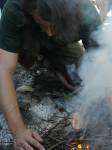Unsurprisingly, many people have never even heard of pit cooking. Getting our food that close to dirt is enough to make anyone uncomfortable, and with the invention of indoor ovens, pit cooking has become widely ignored in our culture. Lately though, there has been a resurgence of similar outdoor cooking trends, including La Caja China BBQ Box | Cajun Pig Roasts.
While that’s a recent and great beach party innovation, another similar example is one of the few remaining traditions surviving the modernized world: the traditional luau Kahlua pig as shown in the video above. These traditional Hawaiian festivities have become famous for the dish, which anyone who’s had the privilege to taste it can attest to its greatness.
While not always practical, pit cooked food is almost always delicious. When you pit cook food, you are essentially creating a giant oven and implementing an early form of baking. Because of the amount of preparation and work involved, pit cooking is best suited to cooking large quantities of food for a large number of people, or situations where you just don’t have an oven available. If you are just cooking for yourself, it often makes much more sense to just throw the food on the fire.
Overall, pit cooking is a very fun and rewarding experience that is worth a try for anyone wishing to experience alternative methods of cooking.
 The Preparation:
The Preparation:
- Dig a large, square or rectangular pit. Consider the size and quantity of the food you are cooking. Make sure the pit is large enough and deep enough to hold the food, hot rocks, coals, and all the insulating plant matter.
- Gather the rocks for the pit. When pit cooking, the inside of the pit is usually lined with rocks. This helps hold in the heat to prevent it dissipating into the surrounding dirt. Line the pit with rocks as best you can. This step is optional however.
- Gather the cooking rocks. The rocks that will be used to actually cook the food must be gathered carefully. These rocks will be super heated in the fire, so if they hold trapped moisture, that moisture will turn into steam and cause the rocks to explode violently. These rocks must be gathered from high and dry ground. Avoid any rocks that have been soaking in water. The dryer, the safer. You will need many fist size or larger rocks. Approximately 10-15 for a small pit, if not more.
- Gather the plant materials. You will need a large amount of green plant matter. Large waxy leaves are great for wrapping the food. Tall green grass is good for insulation and dirt protection.
- Build a large fire. Place the cooking rocks into the fire and let them get red hot. It will usually take over an hour for the rocks to reach the right temperatures.
Getting Down to Business
- Choose the food items you want to cook and season them. Be creative with the spices!
- Wrap the food in the thick waxy leaves and have them ready.
- With a shovel, remove some of the rocks and coals from the fire and put them in the bottom of the pit.
- Cover the hot rocks with a thick layer of green grass, then place the wrapped food in the pit.
- Cover the food with another thick layer of grass.
- Grab the remaining rocks and layer them on top of the grass. You can add coals as well.
- Cover the grass with a layer of waxy leaves to add additional protection from dirt if you want.
- Cover the pit with dirt, but make sure not to pack it down much. Leaving air pockets in the dirt helps keep the heat in.
Cooking Times & Safety
When it comes to the cooking times, it will vary wildly depending on what you cook and how large it is. It also depends on how much food you have in the pit. Keep in mind that it will not cook nearly as fast as an oven. Think of it more along the lines of a giant, dry, slow cooker. It is not uncommon for cooking times to exceed 8 hours or more.
If you are cooking meats such as large roasts or whole birds, make sure to use more rocks and coals, and as you can imagine, many people over the ages have been burned when carrying rocks from the fire to the pit, or by inadvertently falling into the pit, with results ranging from pain, to disfigurement and probably death, especially when it comes to mal-supervised children.
Perhaps less obvious to remember is that you have to make sure the meat is cooked to the proper internal temperature. In particular, meat needs to cook at a higher temperature to be safe for consumption. To learn safe food handling temperatures and procedures, spend an hour getting your food worker’s card and with a little work on your pit cook, you should end up with a fantastic meal. Enjoy!

Charles Borrowman is a graduate of the French Culinary Institute of San Jose, California and a lead instructor with Wolf Camp and the Conservation College. He runs the camp kitchen during our Backcountry Leadership expedition in June, teaches during our Survival, Herbology & Artisan Camps in July-August, and leads our Epic Fishing Camp in late August.











